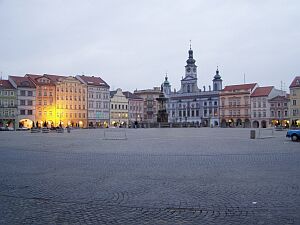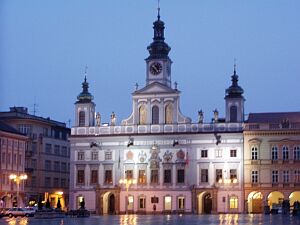Official Name
České Budějovice, from now written as 'Ceske Budejovice' (because some computers may not display the diacritical signs correctly). The German name of the town is more famous - (Böhmisch) Budweis (Bohemian Budweis), also used as the name for the beer. Further to the east there is another, much smaller town called Moravské Budějovice (Moravian-Budweis) - not to be confused with Bohemian Budweis.
Location

| ||
| České Budějovice |
Budejovice is around 125 km south of →Prague and 75 km north of Linz (Austria), conveniently located at the confluence of Malše and Vltava river. The town is the regional centre of Southern Bohemia.
Population
Ceske Budejovice has almost exactly 100,000 inhabitants.
Orientation
The town has a clearly defined old city centre. The České Budějovice nádraží (main train station) is only 500 m east of the centre. The centre itself is egg-shaped, some 400 m wide and 500 m long. It is almost completely surrounded by large sady (parks) and ditches. The Vltava (Moldau) river flows west of the centre northwards with the smaller Malše river joining the Vltava south-west of the old city. Right in the middle of town, the huge nám. Přemysla Otakara II (Premysl II. square) marks the historic centre. Many churches and old buildings line up around the square.

| ||
| The magnificient market square in the historic centre |
History
Ceske Budejovice was founded by the Bohemian king Přemysla Otakar II. in the year 1265 (see also →History of the Czech republic) as a royal city. At that time, the Bohemian king wanted to strengthen his position against the House of Vítkovec. Ceske Budejovice developed quickly and became an important trading place. Especially silver-mining, breweries and salt trade made the town wealthy.
However, Ceske Budejovice suffered a lot during the 30 years' war. In 1641, the town was burnt to the ground. According to historical records, some 200 houses burnt down within one day. Later, the town was rebuilt, predominantly in baroque style. Thanks to the industrial revolution in the 19th century, Budejovice prospered again and was connected to Linz (present-day Austria) via the first commercial European railway line. It must be said that the railway was driven by horsepower only and was only used for transporting goods, mostly salt.
Today the city is worldwide famous for its beer - the Budějovický Budvar (Budweiser Budvar), which is imported to America, Japan and many other countries. The American Budweiser has only one thing in common: the name. The taste is completely different, and so it's hard to have an American Budweiser again after tasting the original.
Getting there / transportation
Ceske Budejovice is en route from →Prague to Linz. It takes around 2½ hrs by train (100 Kč) to the capital. Halfway the beautiful small city →Tábor (1 hour, less then 50 Kč) is definitely worth a visit as well. To Linz in Austria it takes around 3 hours. Additionally, there are direct trains to Plzeň (Pilsen). Some local trains head for →Český Krumlov. Ceske Krumlov is not very far, but the train needs almost one hour (25 Kč). Buses are much faster! There are other long- and short-distance buses to various destinations in the Czech republic and even to Vienna.
The historic centre is not very big and easily covered on foot. However you walk - you will inevitably end up on central náměstí Přemysla Otakara II. This square is almost quadratic and more then 100 m long. The buildings facing the square are surprisingly homogeneous. Almost all of them feature arcades from the 18th century, and so it's possible to walk around the square during torrential rain without getting wet. Many shops and cafés make the square an attractive shopping place. The middle of the square is adorned by the Samsonova kašna (Samson fountain). On the south-west corner, the baroque Radnice (city hall) built in the year 1731 is easy to find.
Only a few meters north of the central square, behind the Mikláš-Cathedral, the so-called Černá věž (black tower) can be seen. The tower was built in the 16th century and is 72 m high. It's possible to climb the tower and enjoy the nice vista of the central square and the surroundings. Unfortunately, the tower is closed during the winter months. There are some large bells inside the tower, the heaviest of them weighing almost 3½ tons.

| ||
| The blue city hall is an eyecatcher |
There is plenty more to see. As there are the former Dominican monastery at the western edge of the old centre, the big South Bohemian Museum in the south-east, many beautiful burgher houses and a handful of churches (Ceske Budejovice was a catholic stronghold) just to name but a few. Last but not least the rather modern Budweiser Brewery located some kilometers away from the centre in an industrial area in the north. It's possible to join a tour through the brewery, which is only possible in groups.
There are many hotels and pensions in the city centre. As in other Czech towns, pensions are the best option. Just ask at the tourist information - there are two of them in the centre. One is next to the city hall, the other one south of central Premysl square.
- www.c-budejovice.cz Official website of České Budějovice. Useful to read before visiting. Comes in English, Czech and German.
Do you have or do you know a good website about České Budějovice? Don't hesitate, let me know! After checking it, I would love to add it to the link list. You can submit a link by using the →contact form. Note that commercial websites will be treated differently.
©2024 Europe-East.com

 Albania
Albania Czech Republic
Czech Republic